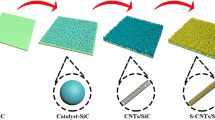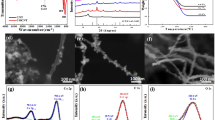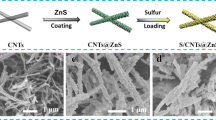Abstract
Ionic liquid (1-ethyl-3-methylimidazolium tetrafluoroborate) treated carbon nanotube (CNT) sponges were tested as a conductive matrix and polysulfide reservoir for the cathode of lithium–sulfur batteries. X-ray photoelectron spectroscopy results confirmed that this treatment doped fluorine and oxygen on the surface of the CNT, and experimental results showed that this treatment had significantly improved adsorption of polysulfides in the CNT sponge. As a result, this sponge cathode accommodated a remarkably high sulfur areal loading of 8 mg cm−2, showing a high areal capacity of 7.1 mAh cm−2 at the 100th cycle at an areal current density of 1.28 mA cm−2 with an average capacity fading of 0.048% per cycle. The adsorbing energy of Li2S6 on the F/O-doped carbon structure was calculated using the density functional theory, confirming that the doping made the polysulfide adsorption stable particularly due to fluorine. This study provides a useful approach of simultaneously introducing both fluorine and oxygen to carbon in order to significantly improve the polysulfide adsorption on the carbon cathode and thereby obtain high areal discharge capacity, which is much more important than specific discharge capacity for actual battery operation.
Graphical Abstract






Similar content being viewed by others
References
Bauer I, Thieme S, Brückner J, Althues H, Kaskel S (2014) Reduced polysulfide shuttle in lithium–sulfur batteries using nafion-based separators. J Power Sources 251:417–422
Elazari R, Salitra G, Garsuch A, Panchenko A, Aurbach D (2011) Sulfur-impregnated activated carbon fiber cloth as a binder-free cathode for rechargeable Li-S batteries. Adv Mater 23:5641–5644
Huang J-Q, Xu Z-L, Abouali S, Garakani MA, Kim J-K (2016) Porous graphene oxide/carbon nanotube hybrid films as interlayer for lithium-sulfur batteries. Carbon 99:624–632
Fu Y, Su Y-S, Manthiram A (2014) Li2S-carbon sandwiched electrodes with superior performance for lithium-sulfur batteries. Adv Energy Mater 4:1300655
Pu X, Yang G, Yu C (2014) Liquid-type cathode enabled by 3D sponge-like carbon nanotubes for high energy density and long cycling life of Li-S batteries. Adv Mater 26:7456–7461
Lu Y, Gu S, Guo J, Rui K, Chen C, Zhang S, Jin J, Yang J, Wen Z (2017) Sulfonic groups originated dual-functional interlayer for high performance lithium-sulfur battery. ACS Appl Mater Interfaces 9:14878–14888
Hwang J-Y, Kim HM, Lee S-K, Lee J-H, Abouimrane A, Khaleel MA, Belharouak I, Manthiram A, Sun Y-K (2016) High-energy, high-rate, lithium–sulfur batteries: synergetic effect of hollow TiO2-webbed carbon nanotubes and a dual functional carbon-paper interlayer. Adv Energy Mater 6:1501480
Bhattacharya P, Nandasiri MI, Lv D, Schwarz AM, Darsell JT, Henderson WA, Tomalia DA, Liu J, Zhang J-G, Xiao J (2016) Polyamidoamine dendrimer-based binders for high-loading lithium–sulfur battery cathodes. Nano Energy 19:176–186
Pu X, Yu C (2012) Enhanced overcharge performance of nano-LiCoO2 by novel Li3VO4 surface coatings. Nanoscale 4:6743–6747
Pu X, Yang G, Yu C (2014) Safe and reliable operation of sulfur batteries with lithiated silicon. Nano Energy 9:318–324
Xiao Z, Yang Z, Nie H, Lu Y, Yang K, Huang S (2014) Porous carbon nanotubes etched by water steam for high-rate large-capacity lithium–sulfur batteries. J Mater Chem A 2:8683
Song J, Xu T, Gordin ML, Zhu P, Lv D, Jiang Y-B, Chen Y, Duan Y, Wang D (2014) Nitrogen-doped mesoporous carbon promoted chemical adsorption of sulfur and fabrication of high-areal-capacity sulfur cathode with exceptional cycling stability for lithium-sulfur batteries. Adv Funct Mater 24:1243–1250
Jung YS, Cavanagh AS, Riley LA, Kang S-H, Dillon AC, Groner MD, George SM, Lee S-H (2010) Ultrathin direct atomic layer deposition on composite electrodes for highly durable and safe Li-ion batteries. Adv Mater 22:2172–2176
Seh ZW, Zhang Q, Li W, Zheng G, Yao H, Cui Y (2013) Stable cycling of lithium sulfide cathodes through strong affinity with a bifunctional binder. Chem Sci 4:3673
Sun L, Kong W, Jiang Y, Wu H, Jiang K, Wang J, Fan S (2015) Super-aligned carbon nanotube/graphene hybrid materials as a framework for sulfur cathodes in high performance lithium sulfur batteries. J Mater Chem A 3:5305–5312
Tang C, Zhang Q, Zhao MQ, Huang JQ, Cheng XB, Tian GL, Peng HJ, Wei F (2014) Nitrogen-doped aligned carbon nanotube/graphene sandwiches: facile catalytic growth on bifunctional natural catalysts and their applications as scaffolds for high-rate lithium-sulfur batteries. Adv Mater 26:6100–6105
Wang H, Tazebay AS, Yang G, Lin H, Choi W, Yu C (2016) Highly deformable thermal interface materials enabled by covalently-bonded carbon nanotubes. Carbon 106:152–157
Pu X, Yang G, Yu C (2015) Trapping polysulfides catholyte in carbon nanofiber sponges for improving the performances of sulfur batteries. J Electrochem Soc 162:A1396–A1400
Wu F, Ye Y, Chen R, Qian J, Zhao T, Li L, Li W (2015) Systematic effect for an ultralong cycle lithium-sulfur battery. Nano Lett 15:7431–7439
Yuan S, Bao JL, Wang L, Xia Y, Truhlar DG, Wang Y (2016) Graphene-supported nitrogen and boron rich carbon layer for improved performance of lithium-sulfur batteries due to enhanced chemisorption of lithium polysulfides. Adv Energy Mater 6:1501733
Guo J, Yang Z, Yu Y, Abruna HD, Archer LA (2013) Lithium-sulfur battery cathode enabled by lithium-nitrile interaction. J Am Chem Soc 135:763–767
Yang G, Choi W, Pu X, Yu C (2015) Scalable synthesis of bi-functional high-performance carbon nanotube sponge catalysts and electrodes with optimum C–N–Fe coordination for oxygen reduction reaction. Energy Environ Sci 8:1799–1807
Erbay C, Yang G, de Figueiredo P, Sadr R, Yu C, Han A (2015) Three-dimensional porous carbon nanotube sponges for high-performance anodes of microbial fuel cells. J Power Sources 298:177–183
Vadahanambi S, Jung J-H, Kumar R, Kim H-J, Oh I-K (2013) An ionic liquid-assisted method for splitting carbon nanotubes to produce graphene nano-ribbons by microwave radiation. Carbon 53:391–398
Pang Q, Nazar LF (2016) Long-life and high-areal-capacity Li-S batteries enabled by a light-weight polar host with intrinsic polysulfide adsorption. ACS Nano 10:4111–4118
Song J, Yu Z, Gordin ML, Wang D (2016) Advanced sulfur cathode enabled by highly crumpled nitrogen-doped graphene sheets for high-energy-density lithium-sulfur batteries. Nano Lett 16:864–870
Liu S, Li Y, Hong X, Xu J, Zheng C, Xie K (2016) Reduced graphene oxide-hollow carbon sphere nanostructure cathode material with ultra-high sulfur content for high performance lithium-sulfur batteries. Electrochim Acta 188:516–522
Chen J, Wu D, Walter E, Engelhard M, Bhattacharya P, Pan H, Shao Y, Gao F, Xiao J, Liu J (2015) Molecular-confinement of polysulfides within mesoscale electrodes for the practical application of lithium sulfur batteries. Nano Energy 13:267–274
Schneider A, Weidmann C, Suchomski C, Sommer H, Janek Jr, Brezesinski T (2015) Ionic liquid-derived nitrogen-enriched carbon/sulfur composite cathodes with hierarchical microstructure-a step toward durable high-energy and high-performance lithium–sulfur batteries. Chem Mater 27:1674–1683
Schneider A, Suchomski C, Sommer H, Janek J, Brezesinski T (2015) Free-standing and binder-free highly N-doped carbon/sulfur cathodes with tailorable loading for high-areal-capacity lithium–sulfur batteries. J Mater Chem A 3:20482–20486
Chung S-H, Han P, Chang C-H, Manthiram A (2017) A shell-shaped carbon architecture with high-loading capability for lithium sulfide cathodes. Adv Energy Mater. https://doi.org/10.1002/aenm.201700537
Chong WG, Huang J-Q, Xu Z-L, Qin X, Wang X, Kim J-K (2017) Lithium–sulfur battery cable made from ultralight, flexible graphene/carbon nanotube/sulfur composite fibers. Adv Funct Mater 27(4):1604815
Zhai P-Y, Huang J-Q, Zhu L, Shi J-L, Zhu W, Zhang Q (2017) Calendering of free-standing electrode for lithium-sulfur batteries with high volumetric energy density. Carbon 111:493–501
Wu Z, Wang W, Wang Y, Chen C, Li K, Zhao G, Sun C, Chen W, Ni L, Diao G (2017) Three-dimensional graphene hollow spheres with high sulfur loading for high-performance lithium-sulfur batteries. Electrochim Acta 224:527–533
Song J, Xu T, Gordin ML, Zhu P, Lv D, Jiang YB, Chen Y, Duan Y, Wang D (2014) Nitrogen-doped mesoporous carbon promoted chemical adsorption of sulfur and fabrication of high-areal-capacity sulfur cathode with exceptional cycling stability for lithium-sulfur batteries. Adv Funct Mater 24:1243–1250
Qiu Y, Li W, Zhao W, Li G, Hou Y, Liu M, Zhou L, Ye F, Li H, Wei Z (2014) High-rate, ultralong cycle-life lithium/sulfur batteries enabled by nitrogen-doped graphene. Nano lett 14:4821–4827
Song J, Gordin ML, Xu T, Chen S, Yu Z, Sohn H, Lu J, Ren Y, Duan Y, Wang D (2015) Strong lithium polysulfide chemisorption on electroactive sites of nitrogen-doped carbon composites for high-performance lithium–sulfur battery cathodes. Angew Chem Int Ed 54:4325–4329
Acknowledgements
The authors acknowledge financial supports from the US National Science Foundation (Award Numbers: IIP 1701200, IIP 1655429, CHE 1410272) and Texas A&M Engineering Experiment Station, and permission to use the Laboratory for Molecular Simulation at Texas A&M University, which was supported by the US National Science Foundation (Award Number: CHE 0541587).
Author information
Authors and Affiliations
Corresponding author
Rights and permissions
About this article
Cite this article
Lin, H.T., Yang, G., Tsao, YY.T. et al. Ionic liquid treated carbon nanotube sponge as high areal capacity cathode for lithium sulfur batteries. J Appl Electrochem 48, 487–494 (2018). https://doi.org/10.1007/s10800-018-1181-7
Received:
Accepted:
Published:
Issue Date:
DOI: https://doi.org/10.1007/s10800-018-1181-7




